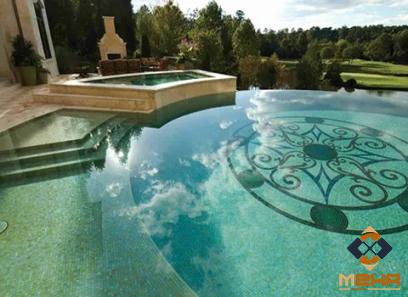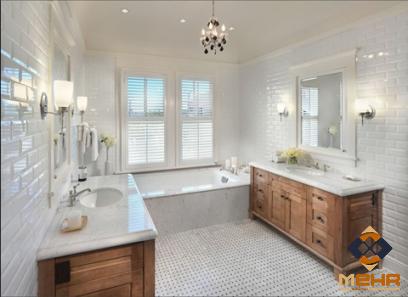Ceramic wall tiles have long been admired for their beauty, durability, and versatility in interior settings. However, their growing popularity in exterior applications, particularly for walls, is a testament to their ability to elevate the aesthetic appeal and durability of any building façade. In this article, we will explore the numerous benefits that ceramic wall tiles provide when used on exteriors. Enhanced Aesthetics: One of the primary reasons for the increasing demand for ceramic wall tiles in exterior applications is their ability to transform the appearance of any structure. Available in a wide range of colors, patterns, and textures, ceramic tiles offer limitless design possibilities and can be customized to complement any architectural style.

.
 Whether aiming for a modern, traditional, or rustic look, ceramic wall tiles allow for creativity and originality while adding a touch of elegance to any exterior. Durability and Longevity: Exterior wall tiles are subjected to various environmental factors such as moisture, UV radiation, temperature changes, and constant exposure to the elements. Ceramic wall tiles are renowned for their durability and ability to withstand these challenges. The dense and non-porous nature of ceramic renders it highly resistant to water absorption, preventing damage from freezing and thawing cycles. Moreover, ceramic tiles are also inherently resistant to fading, cracking, and chipping, ensuring long-term performance and durability even in the harshest climates.
Whether aiming for a modern, traditional, or rustic look, ceramic wall tiles allow for creativity and originality while adding a touch of elegance to any exterior. Durability and Longevity: Exterior wall tiles are subjected to various environmental factors such as moisture, UV radiation, temperature changes, and constant exposure to the elements. Ceramic wall tiles are renowned for their durability and ability to withstand these challenges. The dense and non-porous nature of ceramic renders it highly resistant to water absorption, preventing damage from freezing and thawing cycles. Moreover, ceramic tiles are also inherently resistant to fading, cracking, and chipping, ensuring long-term performance and durability even in the harshest climates.
..
 Low Maintenance: Compared to other exterior cladding materials, ceramic wall tiles require minimal upkeep. Due to their non-porous surface and highly durable properties, ceramic tiles are naturally resistant to stains, mold, and mildew. This makes it easier to clean and maintain a pristine appearance, mitigating the need for frequent and costly cleaning or replacement. Protection and Insulation: Ceramic wall tiles not only enhance the visual appeal of a building exterior but also provide a protective barrier against weather elements. Acting as an additional layer of insulation, ceramic tiles can help regulate temperature fluctuations and reduce energy consumption by preventing heat loss during colder months and keeping the interior cooler in hotter seasons. This adds to the overall energy-efficiency of a building, leading to potential cost savings for the owner.
Low Maintenance: Compared to other exterior cladding materials, ceramic wall tiles require minimal upkeep. Due to their non-porous surface and highly durable properties, ceramic tiles are naturally resistant to stains, mold, and mildew. This makes it easier to clean and maintain a pristine appearance, mitigating the need for frequent and costly cleaning or replacement. Protection and Insulation: Ceramic wall tiles not only enhance the visual appeal of a building exterior but also provide a protective barrier against weather elements. Acting as an additional layer of insulation, ceramic tiles can help regulate temperature fluctuations and reduce energy consumption by preventing heat loss during colder months and keeping the interior cooler in hotter seasons. This adds to the overall energy-efficiency of a building, leading to potential cost savings for the owner.
…
 Sustainability: As awareness about sustainable building practices grows, ceramic wall tiles emerge as an eco-friendly choice for exterior cladding. The production process of ceramic tiles involves natural materials, often sourced locally, and uses less energy compared to other materials. Additionally, due to their long-lasting nature, ceramic wall tiles reduce the need for replacements, minimizing waste and environmental impact. Conclusion: Ceramic wall tiles are increasingly gaining recognition as an excellent choice for exterior cladding due to their inherent beauty, durability, and low maintenance requirements. From enhancing the aesthetic appeal to offering protection and insulation, ceramic tiles provide numerous benefits for building exteriors. Architects, designers, and property owners are opting for ceramic wall tiles not only for their visual appeal but also for their long-lasting performance and sustainability. By choosing ceramic wall tiles, one can elevate the appearance, durability, and value of any structure while contributing to sustainable building practices.
Sustainability: As awareness about sustainable building practices grows, ceramic wall tiles emerge as an eco-friendly choice for exterior cladding. The production process of ceramic tiles involves natural materials, often sourced locally, and uses less energy compared to other materials. Additionally, due to their long-lasting nature, ceramic wall tiles reduce the need for replacements, minimizing waste and environmental impact. Conclusion: Ceramic wall tiles are increasingly gaining recognition as an excellent choice for exterior cladding due to their inherent beauty, durability, and low maintenance requirements. From enhancing the aesthetic appeal to offering protection and insulation, ceramic tiles provide numerous benefits for building exteriors. Architects, designers, and property owners are opting for ceramic wall tiles not only for their visual appeal but also for their long-lasting performance and sustainability. By choosing ceramic wall tiles, one can elevate the appearance, durability, and value of any structure while contributing to sustainable building practices.










Your comment submitted.